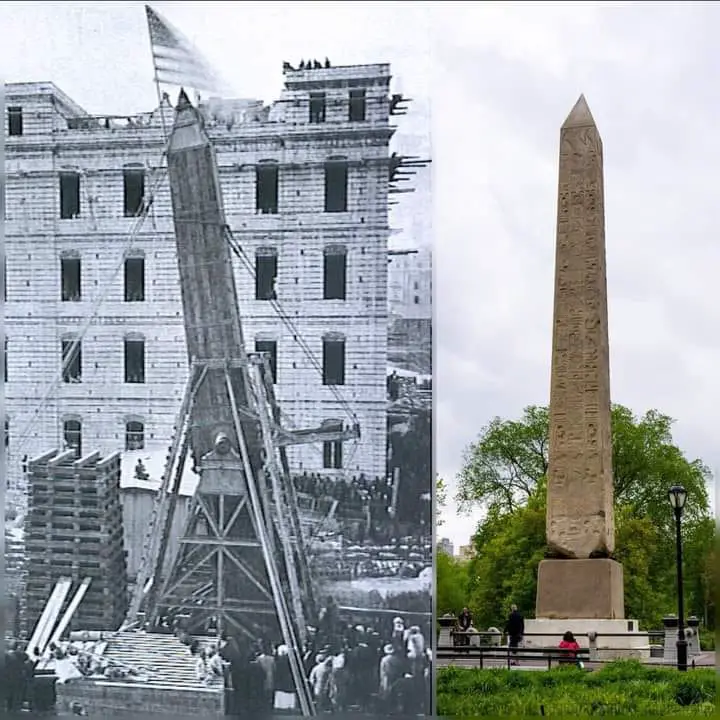Cleopatra’s Needle in Manhattan: An Ancient Marvel in the Heart of New York City
Nestled in the bustling expanse of Central Park stands one of New York City’s most extraordinary treasures: Cleopatra’s Needle. This ancient obelisk, a remarkable relic from Egypt’s past, has graced Manhattan for over 130 years, serving as a timeless link between ancient history and modernity.

A Monument to Pharaoh Thutmose III
Cleopatra’s Needle, estimated to be about 3,500 years old, is New York City’s oldest outdoor monument and the oldest human-made object in Central Park. Its origins trace back to Heliopolis, Egypt, where it was commissioned to commemorate the 30th regnal year of Pharaoh Thutmose III. Carved from a single block of granite, the obelisk stands an impressive 69 feet tall and weighs approximately 200 tons.
Originally intended as a symbol of royal achievement, the obelisk stood proudly in Heliopolis for centuries. However, its fate changed in 525 B.C. when the Persian conquest of Egypt resulted in its toppling. Buried and forgotten for years, it was eventually rediscovered during the reign of Roman Emperor Augustus.
From Egypt to Alexandria: Cleopatra’s Legacy
After its rediscovery, the obelisk was transported to Alexandria under Augustus’s orders. There, it was placed in front of Cleopatra’s Caesarium, a grand temple dedicated to Julius Caesar. This relocation to Alexandria earned the obelisk its popular nickname, “Cleopatra’s Needle,” despite having no direct connection to the famed queen.
For centuries, the obelisk stood as a silent witness to the grandeur and decline of ancient civilizations. Its journey across time and geography would continue, this time crossing continents to find a new home in the United States.
A Gift to the United States
In 1879, the obelisk was gifted to the United States by the Egyptian government. This generous act symbolized the friendship between the two nations and celebrated America’s achievements during the 19th century. However, the task of transporting such a massive and ancient artifact posed significant challenges.
The obelisk was first carefully lowered in Alexandria, a delicate process requiring ingenuity and precision. It was then loaded onto the cargo ship Dessoug for its transatlantic voyage. Upon arrival in New York, the monumental task of moving the obelisk into Central Park began. Workers employed rollers, cranes, and sheer determination to transport the 200-ton monolith to its new location. The journey from the docks to the park took an astonishing 19 days.
A Historic Dedication
On January 22, 1881, Cleopatra’s Needle was finally erected in Central Park. A crowd of 10,000 spectators gathered to witness the historic moment, marveling at the ancient artifact’s grandeur and the engineering feat that brought it to Manhattan.
Standing tall against the backdrop of the modern city skyline, the obelisk remains a striking juxtaposition of ancient and contemporary worlds.
A Timeless Connection to the Past
Today, Cleopatra’s Needle continues to captivate visitors from around the globe. Its hieroglyphic inscriptions, though weathered by time, tell stories of Pharaoh Thutmose III, Ramesses II, and the gods they revered. The obelisk is not merely a decorative piece; it serves as a tangible connection to the ancient world, a reminder of human ingenuity, and a symbol of the enduring allure of history.
For over a century, Cleopatra’s Needle has stood as a sentinel of the past in the heart of New York City. It bridges the gap between ancient Egypt and modern America, offering a glimpse into a time when pharaohs ruled, empires rose and fell, and the mysteries of the Nile inspired wonder across the ages.
Whether you’re a history enthusiast, an admirer of ancient art, or simply strolling through Central Park, Cleopatra’s Needle is a must-see monument. Its presence is a testament to the timeless appeal of human achievement and the power of historical artifacts to transcend time and place.








